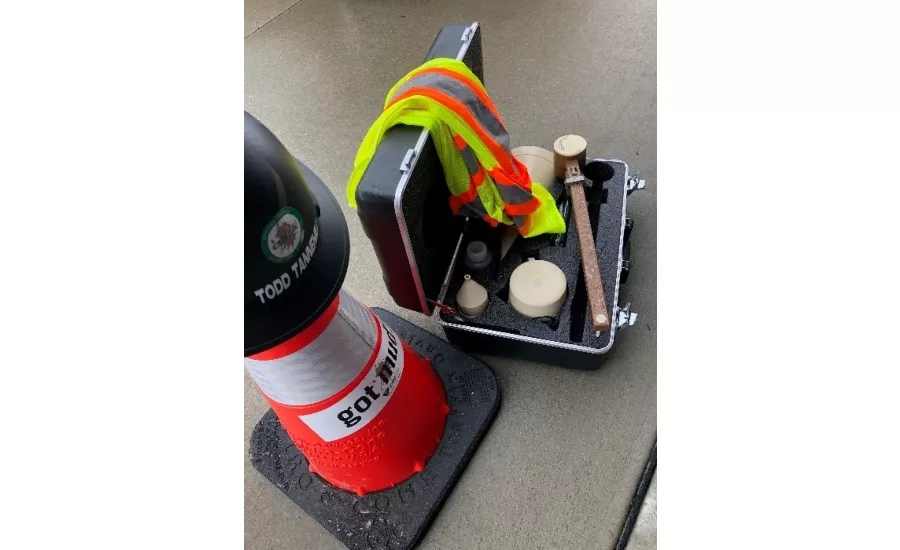For Drillers, It’s the Balance of Power
Mud Scale is Key for Grouting, Solidification, Horizontal Drilling Jobs

A mud balance or mud scale outweighs other fluids tools in usefulness, columnist Todd Tannehill writes.
Source: CETCO Drilling Products
Large drilling operations have a dedicated mud testing program and drilling fluid engineers on site. Their arsenal of tools may include:
- Marsh funnel viscometer
- Sand test
- pH strips or and electronic pH meter
- Filter press
- Rheometer
- Shearometer
- Mud scale
This article focuses on the capabilities of the mud scale. Also known as a “mud balance,” this one tool gets more frequent use in the field than anything else in my testing toolkit. While the types of onsite testing equipment vary from discipline to discipline, the mud scale bridges horizontal, vertical and specialty applications. It also enjoys wide use in both non-oil and gas and oil and gas drilling operations.
Vertical Grouting
In water well, geothermal and other vertical grouting applications, the mud balance allows me to understand and demonstrate the relationship between the drilling mud and the grout. Grout should be heavier than the drilling fluid it displaces. A 20% solid grout weighs ~9.4 pounds/gallon. If your drilling fluid is too dense or you fail to transport cuttings out of the borehole, your fluid column can outweigh your grout. In this case, the grout won’t be able to displace the fluids and setup. Drillers sometimes characterize this as a column of grout that pops up like a collar around the casing. This clear sign indicates disproportionate weights.
A mud balance in grouting can also verify your grout has reached the top of the borehole. Voids and natural cracks in the formation can throw off product estimates. Bentonite drilling fluid and grouts are the same color, so a visual check also has flaws. While the fluid looks thicker, it could be a mix between fluids and the rising grout. Take a mud weight from the top of the borehole to confirm whether your 9.4-pound grout has reached the top. Excess settling of the grout can be a sign that fluids are not being completely replaced by the grout.
Slurry Solidification
As drilling fluid technical folks, we often address questions about slurry solidification. I like to think of my company as an early adopter in the solidification market. We saw the direction of the industry as we witnessed that dumping liquid slurry got harder for clients year after year.
While the solidification agents we use vary by blend (bentonite, bentonite and polymers, polymer only), every blend shares the same process for determining need. Determine the recommended dose of solidification agent using the percent solids by volume.
To estimate this number, weigh the slurry using your mud scale. The lighter the slurry, the closer to liquid or water. Because a lighter slurry is mostly liquid, it takes more solidification material. With this, you are adding solids. A heavier slurry takes less agent, as it has less free liquid to treat. Refer to the chart below to see an example.

Horizontal Directional Drilling (HDD) Recycling
Check the mud weight of returns while drilling a horizontal directional bore to help ensure that you keep downhole pressure within limits. At the lower threshold, keep pressure high enough downhole to create positive pressure against the filter cake and maintain borehole stability. However, if downhole pressures (caused by high solids content and/or viscosity) exceed what the formation can handle, frackouts or fluid lost to the surrounding soil may occur. The heavier the mud weight, the higher the downhole pressure. This is commonly caused when drillers “outrun the mud.”
If the contractor uses a recycler, it is imperative to check the mud weight. This is especially true for drilling in clays where fines can build up in the mud and reach excessive mud weights that cause formation damage. Increasing mud weights can also indicate overloaded desanders and desilters, as well as improper screen selection. “Mud doctors” find the mud scale an invaluable tool on these sites.
Summary
While all the tools tell a different story (density, viscosity, gel strength, etc.) the mud balance or mud scale is one tool that “outweighs them all.” Pun intended!
Looking for a reprint of this article?
From high-res PDFs to custom plaques, order your copy today!


